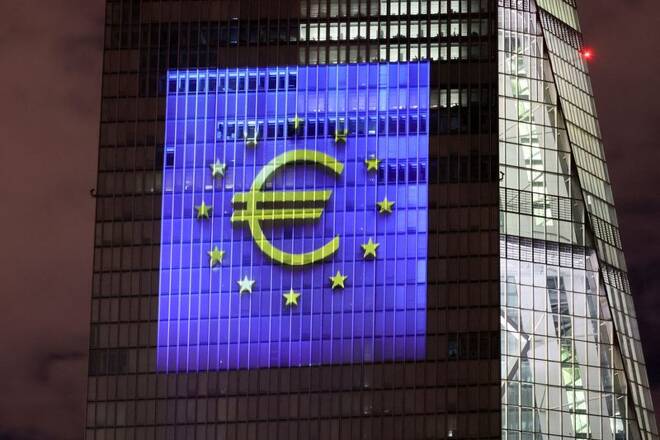Advertisement
Advertisement
Hawkish Fed, German inflation push 10-year Bund yield up closer to 0%
By:
LONDON (Reuters) - Trade in euro zone money markets on Thursday suggested investors were positioning for a rate rise from the European Central Bank as early as October, a day after U.S. markets ramped up rate hike bets after the release of hawkish Federal Reserve minutes.
By Dhara Ranasinghe
LONDON (Reuters) -Germany’s 10-year bond yield lurched closer to positive territory on Thursday, just as borrowing costs across the euro area hit new highs in the face of a hawkish tone from the U.S. Federal Reserve and fresh signs of high German inflation.
Italy’s 10-year bond yield was 4 basis points higher on the day at 1.28%, having jumped to its highest level since July 2020 at almost 1.32%.
Most other 10-year euro area bond yields were up 3-4 bps on the day and at or near multi-month highs, reflecting a broader sell-off in bond markets led by U.S. Treasuries.
In Germany, the yield on 10-year Bunds, which rolled over into a new benchmark, rose to -0.031%, its highest level since May 2019, according to Refinitiv data.
Analysts said that while the rollover into a new contract made the move in Bund yields appear large, even if measured on a continuous basis, yields were at new multi-month highs.
Trading under the new benchmark puts Bund yields within striking distance of 0% – a level it last traded above in May 2019.
Minutes from the Fed’s December meeting, released late on Wednesday, showed that a tight jobs market and high inflation could prompt the U.S. central bank to raise rates sooner than expected and begin reducing its overall asset holdings – a process known as quantitative tightening (QT).
“The discussion about quantitative tightening in the minutes is very significant,” said ING senior rates strategist Antoine Bouvet.
“First and foremost, it shows the magnitude of the Fed’s change of tone as they contemplate a more aggressive balance sheet reduction in parallel to hikes.”
Fed funds futures imply an almost 80% chance of a rate rise to 0.25% at the March Fed meeting.
A ratcheting up of U.S. rate hike expectations spilled over into European markets.
Money market futures dated to the European Central Bank’s October meeting, showed a 10 bps rate hike was almost fully priced in. They also price in 15 bps worth of tightening by December, versus around 13 bps on Wednesday.
Inflation numbers from European powerhouse economy Germany added to the bearish mood in bond markets.
Consumer prices, harmonised to make them comparable with inflation data from other European Union countries (HICP), rose 5.7% year-on-year following a record increase of 6.0% in November, data showed. Germany’s national consumer price index (CPI) rose by 5.3% year-on-year, the highest reading since June 1992.
Germany’s 10-year inflation-linked bond yield rose to two-month highs and was last up 10 bps on the day at -1.79%.
“There is still a sense that (euro area) inflation could surprise to the upside for longer than expected, so markets have to position for the view that the ECB could capitulate and move earlier on rates,” said Mizuho rates strategist Peter McCallum.
“We think inflation will peak but that could come later in Q1.”
(Reporting by Dhara Ranasinghe; Editing by Susan Fenton, Elaine Hardcastle)
About the Author
Reuterscontributor
Reuters, the news and media division of Thomson Reuters, is the world’s largest international multimedia news provider reaching more than one billion people every day. Reuters provides trusted business, financial, national, and international news to professionals via Thomson Reuters desktops, the world's media organizations, and directly to consumers at Reuters.com and via Reuters TV. Learn more about Thomson Reuters products:
Did you find this article useful?
Latest news and analysis
Advertisement
